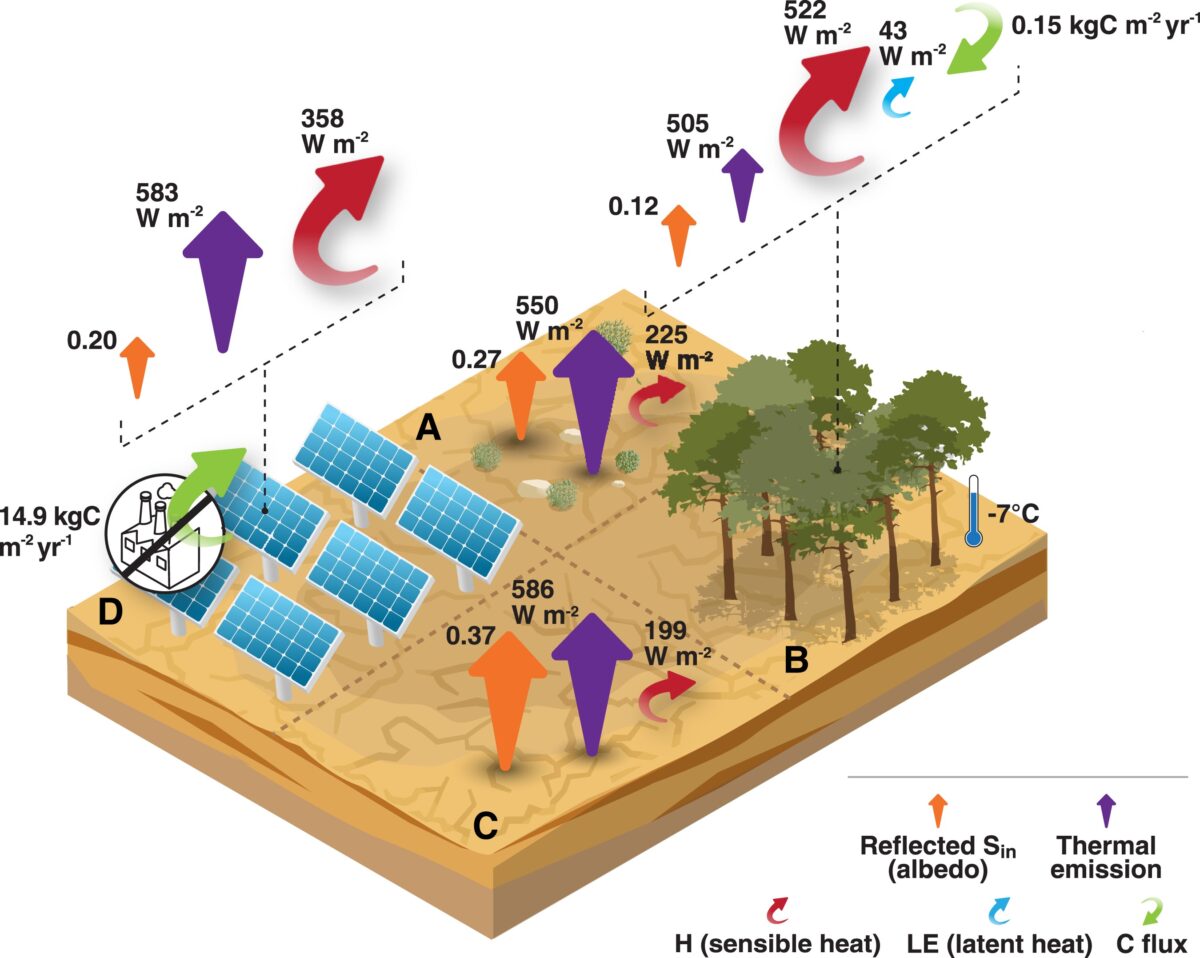Researchers from Israel’s Weizmann Institute of Science have compared how ground-mounted PV and land afforestation may compete in fighting climate change and have found the former may have better chances.
For their simulations, the scientists created a new metric that they called “break-even time” (BET). It calculates the time the two technologies may need to have an effect on carbon emissions and offset the warming impacts caused by the darkening of land.
“PV electricity can significantly contribute to decrease anthropogenic carbon emissions. Forest restoration can play an important complementary role in climate change mitigation efforts by providing an immediate means for actively removing atmospheric carbon,” the researchers said, “However, both have a high land area demand, which may lead to competition for land in areas that can support forests.“
To check which land usage is more efficient, the scientists conducted an array of measurements in the south of Israel, which they said is highly representative of drylands. “Drylands represent a large proportion of the Earth’s land surface, of which nearly half is semiarid and has attracted attention for potential afforestation projects. However, they also can potentially host a significant proportion of utility-scale PV fields,” the group explained as its focus.
Findings
As for the PV effect on the surface temperature, the academics have conducted their research on a PV field in a hyperarid region in the Arava Valley in Israel, next to kibbutz Ketura. That field has an area of 75,600 m2 and an installed capacity of 4.9 MW. That was compared to background measurements from the same area.
According to their measurements, the sensible heat at the PV plant was 359 W m-2. In comparison, in the surrounding background, it was 199 W m-2. Albedo levels were 0.2 and 0.37, respectively. However, according to the calculations, the PV plant would suppress carbon emissions of 14.9 kg m2 per year.
As for the effect of the afforestation of heat levels, the scientist made their measurements at the Yatir forest, the northern edge of the Negev desert in Israel. It is located in a 2,800-ha afforestation of mainly Jerusalem pine trees. That data from there was then compared to data collected from the background desert.
Popular content
In this case, the measurements showed that the sensible heat at the afforestation area was 522 W m2, while in the background, it was 225 W m2. Albedo levels in the afforestation area were 0.12 and in the desert 0.27. According to the calculations, carbon sequestration was at a rate of 0.15 kg m2 per year due to photosynthesis.
“Results show that in drylands, PV fields are over 50 times more efficient than afforestation,” the researchers said, adding that PV fields reach break-even after around 1.4-3.6 years in drylands, while afforestation takes 94–175 years to do so.
Temperate and tropical climates
Furthermore, using their method, researchers then looked to calculate the break-even time of PV and afforestation in other climates, namely temperate and tropical. Data for those were based on previous studies conducted in Germany and Panama, respectively. The results were shown in “Photovoltaic fields largely outperform afforestation efficiency in global climate change mitigation strategies,” published at PNAS Nexus.
“While the relative efficiency of afforestation compared with PV fields significantly increases in more mesic climates, PV field BET is still around 20 times faster than in afforestation,” they added, noting that, in both tropical and temperate climates, PV fields will take less than a year, while in the case of temperate afforestation, it will take 18.5 years, and in tropical afforestation it will take 15.4 years.
“PV electricity generation can prevent much higher carbon emissions than the amount that afforestation can sequester,” they concluded. “However, the active removal of past emitted carbon and the possible long-term storage as biomass and soil organic matter provides an important advantage for afforestation. Forests provide many other ecological benefits compared with this pure climatic perspective.”
This content is protected by copyright and may not be reused. If you want to cooperate with us and would like to reuse some of our content, please contact: editors@pv-magazine.com.


1 comment
By submitting this form you agree to pv magazine using your data for the purposes of publishing your comment.
Your personal data will only be disclosed or otherwise transmitted to third parties for the purposes of spam filtering or if this is necessary for technical maintenance of the website. Any other transfer to third parties will not take place unless this is justified on the basis of applicable data protection regulations or if pv magazine is legally obliged to do so.
You may revoke this consent at any time with effect for the future, in which case your personal data will be deleted immediately. Otherwise, your data will be deleted if pv magazine has processed your request or the purpose of data storage is fulfilled.
Further information on data privacy can be found in our Data Protection Policy.